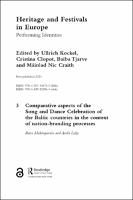Chapter 3 Comparative aspects of the Song and Dance Celebration of the Baltic countries in the context of nation- branding processes
Proposal review
| dc.contributor.author | Muktupāvela, Rūta | |
| dc.contributor.author | Laķe, Anda | |
| dc.date.accessioned | 2019-11-12 13:03:28 | |
| dc.date.accessioned | 2020-04-01T09:30:33Z | |
| dc.date.available | 2020-04-01T09:30:33Z | |
| dc.date.issued | 2019 | |
| dc.identifier | 1006296 | |
| dc.identifier | OCN: 1135844968 | en_US |
| dc.identifier.uri | http://library.oapen.org/handle/20.500.12657/23842 | |
| dc.description.abstract | This chapter focusses on an analysis of the SDC in the context of the development of nation-branding. Two ways of developing international recognition can be outlined: special strategies created by experts and spontaneous, endogenous branding, stemming from traditional cultural symbols important to people. At the beginning of the twenty- fi rst century, the Baltic countries were involved in a purposeful state- fi nanced policy to create their nation brands. During this process, the use of the informal symbol of ‘singing nations’, typical of the Baltic countries, was consciously avoided because of the recommendations of nation- branding professionals. Nevertheless, this symbol, expressed in the form of the SDC, is an important and infl uential agent from the cultural, social, ideological and economic point of view, as well as in contexts of international communication. | |
| dc.language | English | |
| dc.subject.classification | thema EDItEUR::N History and Archaeology::NH History | en_US |
| dc.subject.other | Heritage | |
| dc.subject.other | song | |
| dc.subject.other | dance | |
| dc.subject.other | Baltic countries | |
| dc.title | Chapter 3 Comparative aspects of the Song and Dance Celebration of the Baltic countries in the context of nation- branding processes | |
| dc.type | chapter | |
| oapen.relation.isPublishedBy | 7b3c7b10-5b1e-40b3-860e-c6dd5197f0bb | |
| oapen.relation.isPartOfBook | 92485eae-49d3-4534-86ef-f58799bc9e57 | |
| oapen.relation.isbn | 9780429202964 | |
| oapen.imprint | Routledge | |
| oapen.pages | 19 | |
| oapen.remark.public | 3-8-2020 - No DOI registered in CrossRef for ISBN 9780367186760 | |
| oapen.identifier.ocn | 1135844968 | |
| peerreview.anonymity | Single-anonymised | |
| peerreview.id | bc80075c-96cc-4740-a9f3-a234bc2598f1 | |
| peerreview.open.review | No | |
| peerreview.publish.responsibility | Publisher | |
| peerreview.review.stage | Pre-publication | |
| peerreview.review.type | Proposal | |
| peerreview.reviewer.type | Internal editor | |
| peerreview.reviewer.type | External peer reviewer | |
| peerreview.title | Proposal review | |
| oapen.review.comments | Taylor & Francis open access titles are reviewed as a minimum at proposal stage by at least two external peer reviewers and an internal editor (additional reviews may be sought and additional content reviewed as required). |

